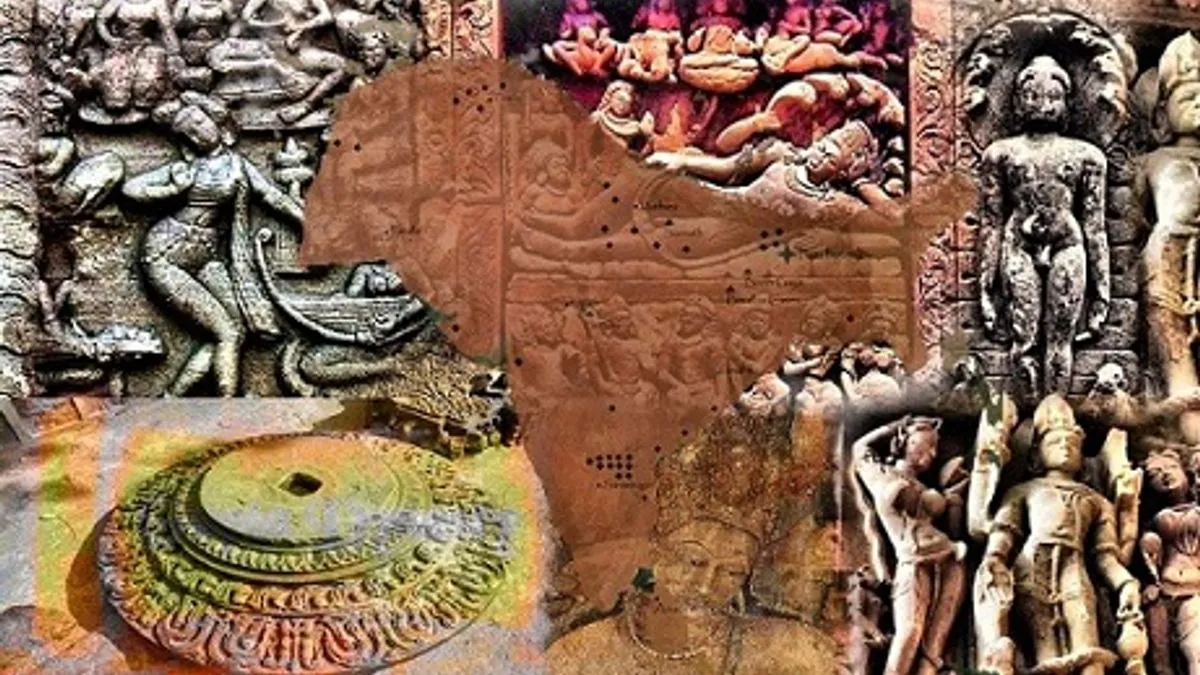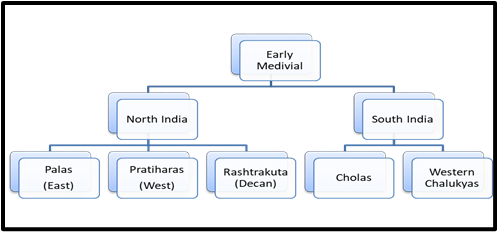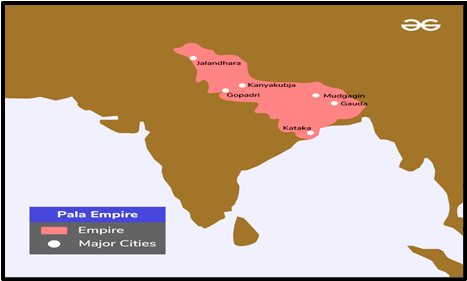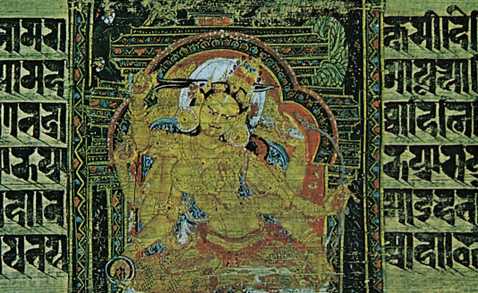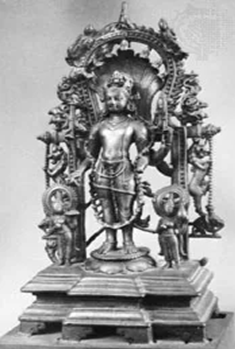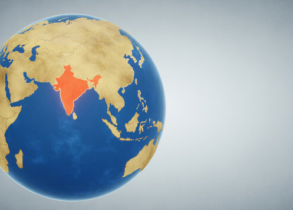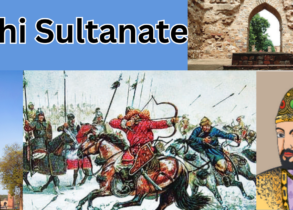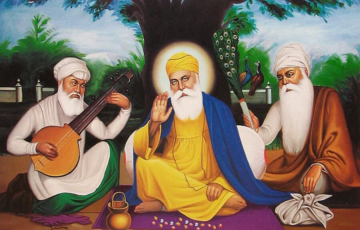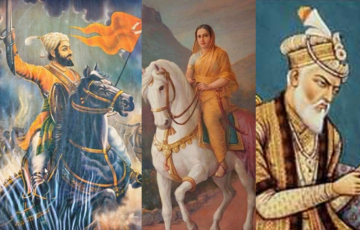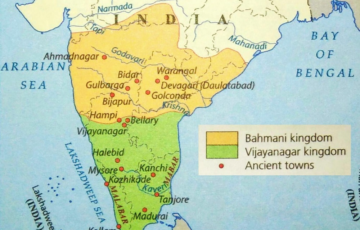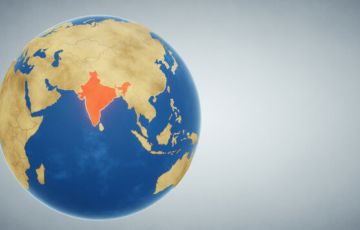EARLY MEDIEVAL PERIOD
The term “early medieval” denotes the transitional era bridging the gap between the ancient and medieval periods. During this time, there was a notable proliferation of local states.
Following the passing of Harsha in 647 AD, Lalitaditya of the Karkota dynasty in Kashmir briefly held sway over Punjab, Kanauj, and parts of Bengal. However, his influence waned as other kingdoms ascended in power. According to Kalhana’s Rajatarangini, Yasovarman from the Varman dynasty of Kannauj in the 8th century was defeated by Lalitaditya. Furthermore, the Martand Sun Temple in Anantnag, Kashmir, was constructed during Lalitaditya’s reign in the 8th century AD.
Palas
Origin of Palas
- Gopala established the Pala Empire in the eighth century.
- In the 7th century, after the death of Harshvardhana, many kingdoms in Northern and Eastern India rose to prominence.
- Shashanka, the ruler of the Gauda Kingdom, was a contemporary of King Harshavardhana and controlled Bengal from 590 to 625 CE.
- Lawlessness prevailed in Northern and Eastern India after Shashanka’s death, allowing the Palas to seize power and establish the Pala Empire.
- The Pala Empire initially governed Bihar and Bengal but experienced territorial fluctuations due to periods of decline and revival.
- Gopala became the first emperor of the Pala Empire amidst the chaos in Bengal following Shashanka’s downfall.
- The Pala dynasty ruled over Bihar, Bengal, and parts of Orissa and Assam for nearly four centuries.
- Arab trader Sulaiman referred to the Pala Empire as “Ruhma” or “Dharma,” signifying their influence.
- The Pala monarchs engaged in conflicts with neighboring powers, such as the Pratiharas and Rashtrakutas, despite having a larger army.
- Pala kings were known to be accompanied by a force of 50,000 elephants in battles.
- The Pala Empire is often considered Bengal’s “Golden Age,” marked by cultural and political prosperity.
Major Rulers of Palas
| Gopala (750–770 AD): | ● Gopala was the founder of the Pala dynasty and the first emperor of the dynasty.
● He ascended to the throne after a revolution aimed at ending the Matsyanyaya, a period of near-anarchy that prevailed in Bengal after the death of Sasanka, the previous ruler of Bengal. ● During Gopala’s reign, the Pala dynasty expanded its control over most of Bihar and Bengal. ● He was the son of a warrior named Vapaata. |
| Dharmapala (770–810 AD): | ● Dharmapala succeeded Gopala as the Pala Empire’s ruler around 770 AD.
● During his reign, a tripartite struggle ensued between the Pala, Prathihara, and Rashtrakuta dynasties for control of Kanauj, a strategically important city in Northern India. ● Dharmapala emerged victorious by defeating the king of Kanauj, Indrayudha, and installing his nominee, Chakrayudha, on the throne. ● He organized a grand darbar at Kannauj, attended by numerous rulers. However, he was unable to maintain his position and faced a defeat by Dhruva, a Rashtrakuta king, in a battle near Monghyr (Bihar), leading to the end of his reign in 810 CE. |
| Devapala (810–850 AD): | ● Devapala, the son of Dharmapala, succeeded his father as the monarch of the Pala Empire.
● He is regarded as one of the most powerful Pala kings. ● Devapala expanded the empire’s territory by conquering regions like Assam and Utkala (Orissa). ● Notably, he defeated the ruler of the Rashtrakuta empire, Amoghavarsha. ● Devapala’s rule continued until 850 CE, and he played a pivotal role in the empire’s history. |
| Mahipala I (988-1038 AD): | ● Mahipala I ascended to the throne in 988 CE, revitalizing the strength of the Pala Empire.
● Under his rule, the Pala dynasty managed to reclaim territories in Bengal’s northern and western regions, as well as north and south Bihar. ● However, following Mahipala I’s rule, the Pala kingdom once again began to decline. ● Ultimately, the Hindu Sena dynasty ruler, Vijayasena, toppled the Pala Empire in the 12th century. |
| Rampala (1077-1120 AD): | ● Rampala was one of the last powerful rulers of the Pala dynasty.
● His reign marked the end of an era for the Pala Empire. ● Unfortunately, during the rule of his son, Kumarapala, the kingdom began to disintegrate. ● Rampala’s court poet, Sandhyakar Nandi, is known for writing the novel “Ramacharitam” in Sanskrit with two meanings, adding to the cultural legacy of the Pala Empire. |
| Note
Following the demise of Sasanka, the ruler of Bengal, the region plunged into a state of profound turmoil and disorder. This period of near-anarchy in Bengal was commonly referred to as “Matsyanyaya.” The term “Matsya Nyaya,” derived from Sanskrit, draws an analogy to the behavior of fishes, where larger fishes prey upon the smaller ones, symbolizing the chaos and lawlessness prevailing in the region. |
Administration of Pala Empire:
- Modeled after Gupta Empire’s administrative practices.
- Monarchical administrative structure with power concentrated in the hands of the king or monarch.
- Pala rulers were bestowed with titles like Parameshwar, Paramvattaraka, or Maharajadhiraja.
- Hereditary passing of the throne within the Pala dynasty.
- King was assisted by hereditary ministers from prominent families.
- Some regions were under direct royal rule, while others were controlled by vassal chiefs with autonomy.
- Vassal regions provided fixed contributions and troops to the king.
- Directly governed lands were divided into provinces known as Bhukti, managed by officials called Uparika, responsible for revenue collection and maintaining law and order.
- Diplomatic efforts to establish trade routes and alliances with other cultures, particularly in the Middle East and Southeast Asia.
Religion of Palas:
- Dominant religions were Buddhism and Hinduism.
- Strong emphasis on Mahayana Buddhism.
- Revived interest in Buddhism in the Indian subcontinent.
- Patronized Shaivism and Vaishnavism.
- Land concessions to Brahmanas and priests.
- Construction of significant monasteries, including the renowned Somapura Mahavihara.
- Spread of Mahayana Buddhism to Tibet, Nepal, Bhutan, Myanmar, and Indonesia.
- Building of temples in Bengal, Bihar, and Assam, such as the Hayagriva avatar temple.
- Coins represented various forms of worship, including Shiva, Vishnu, and Saraswati.
Education under Palas:
- Palas were patrons of education.
- Dharmapala renovated Nalanda University, established Vikramasila University, and Somapura Mahavihara.
- Nalanda became famous worldwide with around 10,000 students and teachers from diverse regions.
- Vikramasila University specialized in Tantra training.
- Graduates like Atia Dipankara contributed to Tibetan Buddhism.
- Somapura Mahavihara was a significant center for various religions.
- Educational influence extended to Cambodia and is a UNESCO World Heritage Site.
Art and Architecture:
- Pala school of sculptural art influenced by Gupta art.
- Renovation and construction of sacred structures at sites like Sarnath, Nalanda, and Bodh Gaya.
- Public works initiatives included the construction of tanks and channels.
- Dhiman and Vitapala were renowned painters, sculptors, and bronze statue makers.
Literature:
- Prominent texts include Agama Shastra by Gaudapada, Nyaya Kundali by Sridhar Bhatta.
- Notable Buddhist scholars from Vikramashila and Nalanda universities.
- Ramacharitam by Sandhyakar Nandi, describing alliances through lavish gifts.
- Patronage of Sanskrit scholars and the development of Gaudi-riti in Sanskrit literature.
- Works related to medicine by Chakrapani Datta, Sureshwar Gadadhara Vaidya, and Jimutavahana.
- Mahipalageet, a set of folk songs popular in rural Bengal, celebrating King Mahipala I.
Palas Paintings:
- Pala School of Painting represents one of India’s earliest forms of miniature painting.
- It is credited as the pioneer of miniature painting in India.
- Significant centers of the Pala School of Painting include Nalanda, Odantapuri, Vikramsila, and Somarupa Buddhist monasteries (mahaviharas).
- Artworks predominantly appear in the form of numerous palm-leaf manuscripts featuring Buddhist themes.
- The Pala style exhibits naturalistic elements, reflecting contemporary bronze and stone sculptures, as well as the classical art of
- A notable example of this style is found in the manuscript of the Astasahasrika-Prajnaparamita (The Perfection of Wisdom in Eight Thousand).
Palas Sculpture:
- Under the patronage of Pala monarchs, the Gupta sculptural tradition reached remarkable heights.
- The Pala school of sculptural art is recognized as a distinctive period in Indian art, with Bengal sculptors achieving unparalleled aesthetic prowess.
- This era witnessed the evolution of new types of stone and bronze sculptures, with a particular emphasis on bronze casting.
- Pala art absorbed various local influences and persisted until the end of the 12th century.
- Stone and copper statues were prolifically erected, especially in monastic sites like Nalanda and Bodh Gaya.
- Most sculptures were inspired by Buddhism, featuring not only Buddha but also Hindu deities like Surya, Vishnu, Ganesh, and others.
- Sculptures typically depict only the frontal aspects of the body.
- The Palas style is characterized by slim and graceful forms, along with intricate jewelry details.
The decline of the Pala Dynasty
- The Pala Dynasty’s decline was hastened under the reigns of rulers like Rajyapala, Gopala III, and Vigramapala II. Their ineffective leadership contributed to the weakening of the dynasty’s power.
- The rise of the Pratiharas, particularly under Mihira Bhoja in Jalore, posed a significant challenge to the Palas. The Pratiharas’ expanding influence encroached upon Pala territories, further eroding their authority.
- The Rashtrakutas also played a role in the decline of the Pala Dynasty by expanding into Pala-controlled regions. This territorial advance added to the pressure on the Palas.
- Vijayasena of the Sena Dynasty emerged as a formidable force and eventually expelled the last Pala ruler, Madanapala (1130–1150 AD), from Bengal. Vijayasena established his own dynastic rule, marking the end of the Pala Dynasty’s era.
Gurjara Pratiharas (Agnikula Rajputs) (8th–11th Century AD)
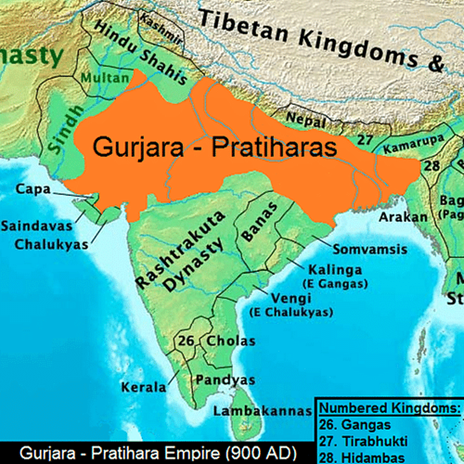
The Pratiharas – Origin:
- The fall of the Pushyabhuti Dynasty, centered at Kanyakubja (modern-day Kannauj, Uttar Pradesh) under Harshavardhana in 647 CE, led to political chaos and instability.
- During this period, various kingdoms rose and fell, but eventually, the Pratiharas, Palas in eastern India, and Rashtrakutas in southern India emerged as dominant powers.
- The Ayudha dynasty ruled over Kanyakubja around the 9th century CE.
- The Gujarat people are seen as either foreigners gradually assimilated into Indian society or local residents of Gurjara land (Gurjaradesha or Gurjaratra) or a tribal group.
- The Pratiharas, deriving their name from the Sanskrit word “pratihara,” meaning “doorkeeper,” are often considered a tribal group or clan within the Gurjaras.
- In the epic Ramayana, Prince Lakshmana served as a doorkeeper for his elder brother King Rama, and the Pratiharas adopted this title as he was considered their ancestor.
- Several Gurjara families began as local officials and eventually established small principalities to the south and east of Jodhpur in modern-day Rajasthan.
- The Pratiharas gained prominence after successfully repelling Arab invaders in the late eighth century CE.
- Their times and rule are documented not only through inscriptions but also through sculptures and monuments erected during their reign.
- Arab merchants who visited India during this period, including Suleiman in the 9th century CE and al-Masudi in 915-16 CE, referred to the Pratihara Kingdom as “al-Juzr” (from the Sanskrit Gurjara) and highlighted the great power and prestige of the Pratihara rulers and the vastness of their empire.
Important Rulers
| Nagabhata I: (730-760 AD) | ● The first significant king of the dynasty.
● Known for defeating the Arabs. ● Fought against the Rashtrakutas but was defeated. ● Successors: Kakustha (nephew) and Devaraja (brother) ruled from around 760 to 775 CE. |
| Vatsaraja (775-800 CE): | ● Conquered most of central Rajasthan after defeating the Bhandi or Bhatti clan.
● Tried to gain control of Kanyakubja politics, defeating the Palas. ● Defeated by Dhruva Rashtrakuta, leading to his refuge in the Rajasthan deserts. |
| Nagabhata II (800-833 CE): | ● Attempted to revive the dynasty’s fortunes.
● Conquered Sindh and eastern India, defeating the Palas. ● Fought against various kings in Gurjaradesha, including the Arabs. ● Lost territories to Rashtrakuta Govinda III but regained some later. ● Captured Kanyakubja, making it the Pratihara capital. ● Successor: Ramabhadra (833-836 CE). |
| Mihir Bhoja (836-885): | ● Ruled for nearly 50 years as Nagabhata II’s grandson.
● Initially defeated by the Palas, Rashtrakutas, and Kalachuris but later launched a successful counter-strike. ● Expanded the empire by annexing parts of the Pala Empire in eastern India and reclaiming territories in Gujarat, Rajasthan, and Madhya Pradesh. |
| Mahendrapala I (885-910 CE): | ● Expanded his father Bhoja’s empire.
● Defeated by the king of Kashmir and ceded some Punjab territories. ● Civil war between his son Mahipala and half-brother Bhoja II followed his death. |
| Mahipala I (c. 912-944 CE): | ● Secured the throne but faced defeat by the Rashtrakutas, allowing the Palas to regain some territories.
● Attempted to recover lost lands but faced further setbacks by the Rashtrakutas. |
| Rajyapala (960-1018 CE): | ● Defeated by Rashtrakuta king Krishna III.
● Mahmud Ghazni’s raid on Kannauj forced Rajyapala to flee, and he was later assassinated. |
| Yashpala (1024-1036 CE): | ● The final ruler of the Pratihara dynasty.
● Reigned during a period when Kannauj was conquered by the Gandhavalas by 1090 CE. |
Wars of Palas and Rashtrakutas:
- The Gurjara-Pratihara kingdom’s expansion led to constant conflicts, known as the “tripartite struggle,” with contemporary powers like the Palas and the Rashtrakutas.
- Control of Kanyakubja was crucial as it symbolized sovereignty in north India and controlled the upper Gangetic valley with its rich resources.
- The Ayudha rulers of Kanyakubja were perceived as weak, prompting the Palas to intervene in their politics.
- The Pratiharas, enemies of the Palas, used this opportunity to attack Kanyakubja and support their own candidate for kingship, leading to conflicts.
- The Rashtrakutas proved formidable opponents for the Pratiharas in their rivalry for control of the upper Gangetic valley and Malwa.
- The rivalry over Malwa and Gujarat began in the eighth century, with the Rashtrakutas emerging victorious in battles against the Pratiharas.
- Despite Rashtrakuta defeats, Pratihara rulers like Nagabhata II and Bhoja rebuilt their empire, with Kanyakubja becoming the Pratihara capital.
- Geographical factors played a role, with control over the Ganges river region being crucial for commerce and trade prosperity.
- Rashtrakutas, based in the south, engaged in campaigns primarily as raids for prestige, booty, and imperial glory.
- Despite setbacks, the Rashtrakutas continued to engage and defeat Pratihara kings into the 10th century.
Religion of Pratiharas:
- The Pratihara era witnessed the advancement of Brahmanical religion.
- Dominant sects included Vaishnava, Shaiva, Sakta, and Surya, with Brahmins enjoying high status.
- Temples and statues were considered sacred, constructed with support from kings and the wealthy.
- Shaivas worshiped Siva under various names, including Indra, Sankar, Pashupati, and more.
- Temples and religious buildings were constructed, contributing to the cultural and religious landscape.
Administration of Pratiharas:
- The administration was influenced by the Gupta Empire’s practices and Harshavardhana’s ideas.
- The king held supreme authority and was aided by ministers and officials.
- Vassal kings and dynasties were expected to be loyal, pay tribute, form alliances, and supply troops.
- Some regions were directly administered, divided into provinces and districts governed by officials.
- Villages remained fundamental administrative units, with headmen and officials receiving land grants.
- Vassals, like the Paramaras and Chandellas, often sought independence and fought against the king.
Art and Architecture of Pratiharas:
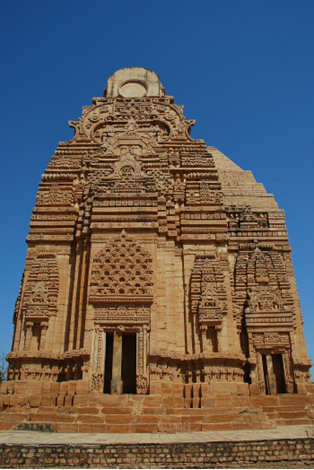
- Pratihara rulers were patrons of the arts, architecture, and literature.
- Notable sculptures include the Viswaroopa form of Vishnu and the Marriage of Siva and Parvati.
- Carved panels adorned temple walls at various sites.
- The Teli-ka-Mandir in Gwalior, dedicated to a Shakti cult, remains a significant architectural work.
The Decline of the Pratiharas:
- The Pratiharas faced military defeats and setbacks under successive rulers.
- Rashtrakuta invasions, Rajput feudatories, and central power weakness contributed to their decline.
- Feudatories and provincial governors sought independence as the empire disintegrated.
- Eventually, the Pratihara kingdom dwindled to the Kanyakubja region.
- In the early 11th century CE, the Ghaznavid Turks conquered the Pratihara kingdom, ending their rule.
The Rashtrakutas (753-975 AD)
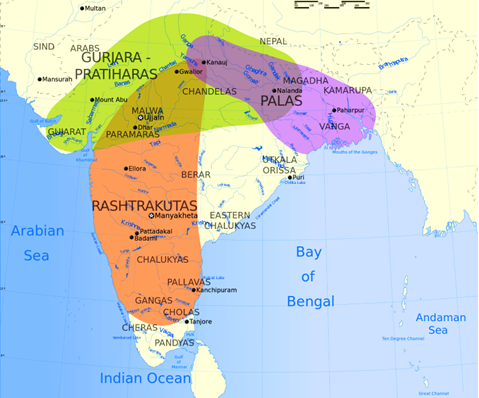
Origins
- The Pratiharas claimed their lineage from the Rathikas, a clan mentioned in the edicts of Ashoka, hailing from the Kannada-speaking region.
- In the early medieval period, around 743 AD, the Rashtrakutas, also known as Ballahara by the Arabs, emerged as a significant power in the Deccan.
- They ruled from their capital at Manyakheta, which corresponds to present-day Malkhed.
- The Rashtrakutas held prominence for approximately two centuries, acknowledged in both Sanskrit and Arabic records as a dominant force in India.
- Arab travelers described the Rashtrakuta ruler as “the king of kings (malik al-muluk)” of al-Hind, emphasizing their significant status.
- Al-Masudi, among other Arab accounts, provided vivid descriptions of the grandeur of the Rashtrakuta kingdom, attributing its immense wealth to profits from maritime trade.
| Dantivarman or Dantidurga (735–756 AD): | ● He is founder of the dynasty, conquered several territories including the Gurjara-Pratiharas in Malwa. Dantidurga
● He performed the Hiranyagarbha ritual (literally meaning ‘golden womb’,) to claim kshatriya status. |
| Krishna I (756-774 CE): | ● Succeeded Dantidurga and ended the Badami Chalukya dynasty’s rule.
● Expanded the kingdom by defeating the Gangas, subjugating the Konkans, and securing the submission of the Eastern Chalukya kingdom of Vengi. ● Notable for constructing the Kailasa Temple of Ellora. |
| Dhruva Dharavarsha (780-793 CE):
|
● Marked the beginning of the Rashtrakutas’ golden age.
● Conquered imperial Kannauj and waged battles against Gurjara-Pratihara and Pala dynasties, initiating the tripartite struggle for control of India’s heartland. |
| Govinda III (793-814 CE): | ● Proved to be the most powerful emperor of the dynasty.
● Expanded the kingdom from Kannauj to Cape Comorin and from Banaras to Gujarat. ● Defeated numerous rulers, including the Gurjara-Pratihara king Nagabhata II and King Dharmapala of the Pala Empire. |
| Amoghavarsha I (814-878 CE): | ● Established a new capital at Manyakheta and expanded the kingdom.
● Known for his support of education and literature. ● Converted to Jainism and was praised by Arab merchant Suleman as one of the world’s greatest kings. |
| Indra III (914-929 CE): | ● Notable for destroying Meru, possibly referring to Kanauj.
● Promoted literature and saw the publication of works like Damayanti Katha and Madalasa Champu. ● Succeeded by his son, Amoghavarsha II. |
| Krishna III (939-967 CE): | ● Consolidated the empire, stretching from the Narmada to Kaveri.
● Engaged in conflicts against the Paramars of Malwa and the Eastern Chalukya of Vengi. ● Defeated Chola king Parantaka I and annexed the northern Chola Empire. |
| Karka (972-973 CE): | ● Ascended to the throne after his uncle Khottiga’s death during a Malwa invasion in 972 CE.
● The kingdom faced destruction and plundering. ● Killed by Chalukya king Tailapa II during a Chalukya invasion in 973 CE. |
Administration of Rashtrakutas:
- Supreme authority rested with the King.
- Succession was hereditary, but the abilities of the new ruler were considered.
- The kingdom was divided into provinces governed by Rashtrapatis.
- Districts were overseen by Vishayapatis, and trustworthy ministers ruled over multiple provinces. Its similar to present time DM.
- Nadugowdas oversaw districts, while Gramapatis managed villages.
Literature of Rashtrakutas:
- Kannada literature thrived during the Rashtrakuta Dynasty, ending the Prakrit and Sanskrit eras.
- King Amoghavarsha wrote “Kavirajamarga,” the first available Kannada book.
- Bilingual writers like Asaga and scholars like Mahaviracharya contributed.
- Jain writer Adikavi Pampa and Sri Ponna were prominent Kannada writers.
- Prose works in Sanskrit also fl
Art and Architecture of Rashtrakutas:
- Rashtrakutas made significant contributions to rock-cut cave temples, including Ellora and Elephanta in Maharashtra.
- Renovated Buddhist caves and dedicated Jain temples at Ellora.
- The Kailasa Temple in Ellora, commissioned by King Dantidurga, is one of the world’s largest rock-cut temples.
- The Dhumer Lena and Dashvatara cave temples in Ellora, as well as Jogeshvari temple near Mumbai, are notable.
- Rashtrakutas built temples like Kashivishvanatha and Jain Narayana at Pattadakal, Karnataka.
Society and Culture of Rashtrakutas:
- Subjects looked up to the King for justice and peace.
- Guilds and co-operatives settled disputes based on custom.
- Society was divided into castes based on profession.
- Rashtrakuta rulers were tolerant of all religions.
Religion and Language:
- Rashtrakutas promoted Kannada as a language of daily communication alongside Sanskrit.
- Supported Sanskrit, which was a language of the elite.
- Prominent Jain scholars flourished in the Rashtrakuta court.
- Iconic Kannada poets like Adikavi Pampa and Sri Ponna contributed to the language.
Decline of Rashtrakutas:
- The decline began with Khottiga Amoghavarsha’s defeat and death at the hands of a Paramara ruler in 972 CE.
- Capital Manyakheta was plundered and destroyed.
- Indra IV, the last ruler, committed suicide in 982 CE, marking the end of the dynasty.
- Parts of their kingdom were annexed by later dynasties, but Rashtrakuta influence endured in government systems and cultural practices.
Dynasties of the North
Following the decline of Harsha’s empire, Rajput dominance emerged in the 7th century and endured until the 12th century. The term “Rajaputas,” derived from “Rajputra,” signifying “ruler’s son,” epitomized their valor, allegiance, and noble lineage. Revered as battle-hardened warriors, they assumed governance responsibilities and hailed from patrilineal clans across western, central, and northern India. They proudly traced their ancestry to the ruling military aristocracy of North India.
Rajputs – Background
- Rajputs are believed to have originated from a blend of foreign invaders and Indian Kshatriyas.
- Over time, these invaders assimilated into Indian society, as supported by various Rajput legends.
- The formation of the Rajput clan is thus attributed to multiple contributing factors.
- Rajputs are organized into 36 clans, each belonging to one of three primary lineages or vanshas: Suryavansh, Chandravanshi, and Agnivanshi.
- The Suryavanshi lineage is associated with Surya, the Hindu Sun God, and is known as the Solar Dynasty.
- The Chandravanshi lineage traces its descent from Chandra, the moon, and is known as the Lunar Dynasty.
- Agnivanshi Rajputs claim lineage from Agni, the Hindu god of fire.
- Each lineage is further divided into multiple clans or kulas.
- These clans assert direct patrilineage from a common male ancestor belonging to their respective lineage.
- Despite the divisions, there exists a shared heritage among Rajputs, rooted in their ancestral lineage.
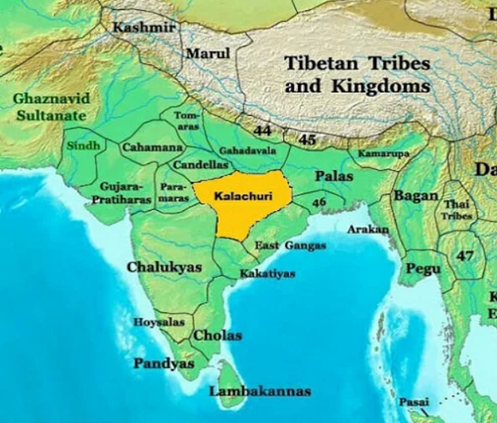
| The Chandellas of Jejakabhukti (Bundelkhand) | Origin and Early Period:
● The Chandellas of Jejakabhukti (Bundelkhand) initially served as feudatories to the Gurjara Pratiharas. ● They traced their lineage back to the sage Chandratreya. ● The dynasty was established by Nannuka around 831-845 AD. Architectural Legacy: ● Chandella’s architectural brilliance is showcased in the magnificent temples at Khajuraho. Important Rulers and Events: ● Yasovarman (925-950 AD): ● First autonomous Chandella ruler who expanded his realm in North India. ● Dhanga/Dhangdev (950-999 AD): ● Son of Yasovarman who annexed Pratihara territories and supported Shahi ruler Jaipal against Subuktigin. ● Ganda/Gandadev (999-1002 AD): ● Son of Dhanga, assisted Jaipal’s son Anandpal against Mahmud Ghazni. ● Vidyadhara (1003-1035 AD): ● Powerful Chandella king who subdued the Pratiharas. ● Paramardideva (1165-1203 AD): ● Faced defeats from Prithvi Raj III and Qutbuddin Aibak but regained Kalinjar by 1205, which remained under native rulers until 1545. |
| Paramaras of Malwa:
|
Origin and Early Period:
● Originally vassals of the Pratiharas and Rashtrakutas, they became independent in the second half of the 10th century. ● Upendra (Krishnaraja) founded the dynasty with Dhar as its capital. Notable Rulers: Munja/Vakapatiraja II (972-990 AD): ● Patron of art and literature, notable for hosting poets like Dhananjaya and Padmagupta. Raja Bhoja: ● Reached the dynasty’s zenith. ● Assisted Anandapal against Mahmud Ghazni. ● Faced attacks from Chalukya and Kalachuris. ● Joined a confederacy of native chiefs that conquered areas from the Turks. ● Founded the city of Bhojapur and authored several books on various subjects. Mahālakadeva (died 1305 AD): ● Last ruler of the Paramara dynasty, defeated by the forces of Alauddin Khalji. |
| Tomaras of Dhillika (Delhi) (8th-12th century AD):
|
Background:
● Ruled Hariyana (Haryana) with Dhillika (Delhi) as their capital, initially under the Pratiharas. ● Referred to as “Tuar” in medieval bardic literature, categorized among the 36 Rajput clans. ● Often clashed with the Chahamanas of Shakambhari, followed by their rule. ● A 13th-century Palam Baoli inscription traces the lineage of rulers in Hariyana to the Tomaras. Important King: ● Anangapala Tomara, credited with establishing Delhi, mentioned in the 11th-century inscription of the iron pillar at Mehrauli. ● His coins featured a horseman-and-bull figure with the title “Shri Samanta-deva,” resembling those of the Shakambhari Chahamana kings. Contributions: ● Pioneered construction of early waterworks in Delhi. ● Anangapala II founded Lal Kot citadel in Mehrauli and constructed Anang Tal tank. ● Surajpala commissioned the Suraj Kund reservoir near Faridabad, Haryana. |
| Chahamanas or Chauhans of Sakambhari (6th-12th century AD):
|
Background:
● Named after their capital, Sambhar in Rajasthan, founded by Simharaja (944−971 AD). Important Rulers: Ajayaraja (1110−1135 AD): ● Reclaimed Nagor and established Ajmer (Ajayameru), coins featured Queen Somaldevi’s name. Arnoraja: ● Halted Yaminis and formed an alliance with the Chalukya ruler of Gujarat through marriage. Vigraharaja IV (1150−1164 AD): ● Expanded the kingdom into an empire by capturing Delhi and Hansi. ● Patron of literature, commissioned works like drama Harakeli and Lalita-Vigraharaja. ● Constructed the Adhai din ka Jhonpra, originally a college, now a mosque. Prithviraj III (1177−1192 AD): ● Military Campaigns: Led expeditions against Kannauj, Gujarat, and Chandella. ● Literary Works: Chandbardai composed “Prithviraj Raso” in Braj Bhasa, detailing the life of Prithviraj III. ● “Prithviraj Vijaya” provides another account of his reign, authored by Jayanaka. ● Wars with Muhammad Ghori: 1. First Battle of Tarain (1191): Ended in victory for the Rajputs, although Muhammad of Ghor managed to escape and return to Ghazni. 2. Second Battle of Tarain (1192): Prithviraj faced defeat against Muhammad Ghori, leading to the ascendancy of Muslim rule in India. Legacy: ● Branches of the Chauhans ruled at Ranthambore, Nadol, and Jalore, later captured by Alauddin Khalji in the early 14th century. |
| Gahadvalas of Kannauj (11th-12th century AD):
|
Background:
● Suryavanshi Kshatriyas who ruled Kannauj in the late 11th century, displacing the Palas from Bihar and establishing Banaras as their secondary capital. Rulers and Contributions: Chandradeva (~1090 AD): ● Founder of the dynasty, captured Delhi from the Pratiharas and Rashtrakutas. Vijayachandra (1154−1170 AD): ● Successfully defended against Ghaznavid aggressions, though lost control of Delhi during his reign. Jaichandra (1170−1194 AD): ● Lost Delhi to the Chauhans under Prithviraj Chauhan. ● Defeated by Mohammad Ghori in the Battle of Chandawar (1194 AD), leading to the kingdom’s sack. ● Grandson Siyaji founded the Rathore clan, ruling Marwar from Jodhpur. Decline: ● The dynasty’s glory ended with the conquest by Iltutmish. |
| Kalachuris of Tripuri (10th-12th century AD):
|
Background:
● Established by Kokalla-I (845-855 AD), known for defeating Turkish troops and forming alliances with the Chandella through marriage. ● Early seat of power was Mahismati on the Narmada. Contributions: ● Hosted renowned poet Rajasekhara at their court. ● Despite decline in the late 10th century, resurged under Gangeyadeva around 1015 AD in Jabalpur. ● Karna, the greatest ruler, expanded territories including Banaras and Prayagraj, allying with the Chalukyas against the Malwa. |
| Chalukyas (Solanki) of Gujarat (950-1300 AD):
|
Notable Rulers and Events:
Bhima I (1022-1064 AD): ● Faced Mahmud Ghazni’s invasion and the plunder of Somnath temple. Jayasimha Siddharaja (1092-93 AD): ● Expanded the kingdom, taking the title of Avantinath after conquering parts of Malwa. ● Known for constructing the RudraMahakala temple and patronizing Jain scholar Hemachandra. Kumarpala: ● Last renowned royal proponent of Jainism, faced Muhammad Ghur’s invasion. ● Karna II confronted Alauddin Khalji’s forces in the later years. |
Dynasties Of East and North-East
The Pralamba (Assam)
- The Pralamba dynasty emerged in the ninth century in the Assam region.
- An unidentified king from this dynasty successfully repelled Bakhtiyar Khalji’s attack, causing significant losses to the invaders.
- By the mid-13th century, the Ahoms, a subgroup of the Shan tribe, established the Ahom Kingdom, leading to the region being named “Assam”.
- The Ahom state depended heavily on forced labor, with those compelled to work for the state called paiks.
Varmans and Senas (East Bengal):
- The Varmans rose to power in the early 11th century, followed by the Senas, possibly originating from the Kannada-speaking region and claiming links with the kings of Dakshinapatha.
- Vijayasena, a significant Sena king ruling from 1095, played a crucial role in the region’s cultural development, with his reign detailed in the Deopara Prasahsti inscription.
- Ballala Sena, Vijayasena’s successor, was noted for his scholarship and for introducing the social system of Kulinism.
- Lakshmanasena, the last Hindu ruler of Bengal and son of Ballal Sena, contributed to cultural advancements during his reign, hosting notable literary figures at his court.
- The Deva dynasty overtook control of Vanga from Lakshmanasena’s successor in the mid-13th century.
Kalinga (Orissa):
- Orissa was under the rule of Sainyabhita Madhavavarman (Srinivasa) of the Shailodbhava dynasty in the mid-7th century, known for conducting the Ashwamedha sacrifice.
- The Shailodbhava dynasty ruled until the mid-8th century, after which Orissa witnessed the reign of several dynasties, notably the Karas and Bhanjas.
- The Eastern Gangas, related to the Gangas of Mysore, established dominance in Kalinga, with Kalinganagara as their capital.
- Anantavarman Chodaganga unified Utkal and Kalinga around 1078 AD, expanding Orissa’s territorial extent.
- Anantavarman Chodaganga annexed Chola lands despite facing a Chola invasion, laying the foundation for modern Orissa and constructing the Jagannath temple.
- The kingdom maintained control up to the Ganges and resisted invasions from Bengal, including one from Bhaktiyar Khalji.
- Narasimha I commissioned the construction of the Sun Temple at Konark in the 13th century.
- In the mid-15th century, the Suryavamsas came to power in Kalinga, succeeding the previous ruling dynasty.
- The Lingaraj temple in Bhubaneswar, dedicated to Shiva, was built by Somvanshi King Yayati I.
Dynasties Of the Deccan and South India
Chalukyas of Kalyani (10th-12th century AD)
- Taila II (973-997 AD) established the Chalukyas of Kalyani after succeeding the Rashtrakutas. Their capital was situated in Kalyani, in modern Bidar district, Karnataka.
- Taila II subjugated neighboring realms, including the Gangas of Mysore, Paramaras of Malwa, Chalukyas of Gujarat, and Kalachuris of Chedi.
- This period witnessed a significant Chalukya-Chola rivalry, with the Tungabhadra River serving as the de facto border between the two kingdoms.
- Vikramaditya VI introduced the Chalukya-Vikram era, replacing the Saka era. He patronized renowned scholars such as Bilhana, the composer of Vikramanankadevacharita, and Vijnaneshvara, the author of Mitakshara.
- By the mid-12th century, the Chalukya reign declined, paving the way for the rise of the Kakatiyas of Warangal, Hoysalas of Dwarasamudra, and Yadavas of Devagiri.
- The Eastern Chalukyas of Vengi, initially Chola protectorates, eventually became part of the Chola Empire under Koluttunga.
Yadavas of Devagiri
- The Yadavas, who claimed descent from the Yadu family of Lord Krishna, were believed to be an indigenous Maratha group and were originally feudatories of the Rashtrakutas and later the Western Chalukyas.
- Bhillama V established the Yadava kingdom with Devagiri as its capital. The kingdom engaged in conflicts with the Hoysalas over territories of the declining Western Chalukya empire.
- Simhana (1210-1246) led the Yadava kingdom to its zenith, while the last notable ruler, Rama Chandra Deva, faced invasion by Alauddin Khalji.
Kakatiyas (950-1323 AD)
- Originating from an ancient Telugu family, the Kakatiyas were initially feudatories to the Western Chalukyas.
- Beta I, the earliest known chief, established a small kingdom in the Nalgonda district (Hyderabad). Following the demise of the Western Chalukya king Vikramaditya VI, the Kakatiyas expanded their territory by defeating Chalukyan feudatories.
- Ganapati, a prominent Kakatiya ruler, centralized power over the Telugu region, focusing on administrative efficiency and promoting trade and agriculture.
- He completed the construction of the city of Warangal and made it the capital.
- Rudramadevi, daughter of Ganapati, assumed the name Rudradeva Maharaja and ruled for approximately 35 years, facing threats from Orissa and the Yadavas. She also patronized Pasupata Saiva monasteries.
- Pratap Rudra (1295-1323), grandson of Rudramadevi, was the last ruler of the dynasty.
- Motupalli served as the chief port of the Kakatiyas, visited by the Venetian traveler Marco Polo.
Chola Empire (later half of 9th-13th century)
Introduction:
- The Cholas were one of the three powerful dynasties that ruled the Tamizh country in the early historical period. References to them can be found in Sangam literature where they are described as one of the Muvendhar, and they are also mentioned in the rock edicts of Ashoka.
- The Chola empire saw a revival in the mid-9th century under Vijayalaya, who conquered the Kaveri delta from the Muttaraiyar and founded the city of Thanjavur.
- Later Cholas traced their lineage back to Karikala, a renowned ruler of the Sangam age.
- Further expansions were made under Aditya (Rajaditya) and Parantaka I, resulting in clashes with Rashtrakuta King Krishna II, including the Battle of Takkolam in 949 A.D.
Important Rulers:
Rajaraja I (985-1014 AD):
- Rajaraja I’s reign is compared with Samudragupta in terms of its political significance.
- He conducted naval expeditions and conquered territories along the West Coast, Sri Lanka, and the Maldives. He also established direct control over northern and eastern parts of Sri Lanka.
- Rajaraja I integrated conquered territories and appointed “viceroys” to oversee regions such as Pandinadu, Sri Lanka (later renamed Mummudicholamandalam), and the Gangavadi region of southern Karnataka.
- Notable architectural accomplishment includes the construction of the Brihadesvara temple at Thanjavur (known as the Rajarajeswara temple), with his achievements engraved on its walls. He also aided in the construction of a Buddhist Vihara in Java.
Rajendra I (1014-1044 AD):
- Rajendra I, son of Rajaraja, saw the peak of Chola power during his reign.
- His conquests are detailed in inscriptions such as the Tiruvalangandu copper plate and Tirumalai rock inscriptions.
- Military campaigns included expansion of the Chola Empire up to the Tungabhadra River by defeating the Western Chalukyas, as well as invasions of Madurai and Sri Lanka.
- He assumed titles such as Mudikonda Cholan, Kadaramkondan, and Pandita Cholan, reflecting his conquests and scholarly pursuits.
- Rajendra I also led naval expeditions against the Sri Vijaya kingdom in southern Sumatra, promoting trade between the Malaya peninsula and South India.
Kulottunga I (1070-1122 AD):
- The last significant Chola ruler, Kulottunga I, unified the Eastern Chalukyas of Vengi with the Cholas.
- He initiated administrative reforms, including land surveys.
- Despite being a Shaivite, Kulottunga I made grants to Buddhist shrines at
- His reign saw challenges from the Hoysalas, Pandyas, and Cheras, resulting in the decline of the Chola empire, eventually overtaken by the Hoysalas and Pandyas.
| Note
Sambuvarayar: Chieftains or feudatories in the North Arcot and Chengalpattu regions during the reigns of Chola kings Rajathiraja and Kulothunga III. |
Chola Administration:
- The king held central authority in Chola administration, supported by royal princes, a ministerial council, and administrative staff. State officials received land grants and titles as rewards and honors for their service.
- Kings were often addressed with titles like Peruman or Perumagan (meaning “great man”), Ulagudaiyaperumal (lord of the world), and Ulagudaiyanayanar (lord of the world), later adopting titles such as Chakkaravarti (emperor) and Tiribhuvana Chakkaravarti (emperor of three worlds).
- The empire was divided into provinces called mandalas, further subdivided into valanadus and nadus.
- Brahmins were appointed as Rajaguru by Chola rulers and were granted Brahmadeyams (large tax-exempt estates) and Chatur-vedimangalams (tax-exempt villages) as a form of patronage.
Local Administration:
- Local administration was managed by various village assemblies such as ur, sabha, mahasabha, and nagaram.
- Ur assemblies were for all landholding classes, sabha assemblies were for Brahmins in Brahmadeya villages, and nagaram assemblies were for merchants.
- The Uttaramerur inscriptions crafted during the rule of Parantaka Chola I provide insights into the local administration, detailing the process of electing members to various committees governing Brahmin settlements.
Army:
- The Cholas maintained a well-organized army consisting of infantry, cavalry (Kudirai Sevagar), and an elephant corps (Anaiyatkal).
- Military infrastructure included cantonments (Padaividu) in the capital city, military outposts (Nilaipadai) in conquered territories, and ranks such as Dandanayagam (commander-in-chief) and Perundanam (upper rank).
Economy
Land Survey:
- The Cholas conducted extensive land surveys under rulers like Rajaraja I, Kulotunga I, and Kulotunga III, employing surveyors known as Naduvagaiseykira.
Taxation:
- Tax rates were based on soil fertility and landholder status, with temples and Brahmins exempt from taxes.
- Primary land taxes (Irai, Kadamai, Opati), labor/service taxes (Kudimai), and taxes on non-agricultural professions (Pattam, Ayam) were levied.
- Taxes were collected in kind, with units of measurement such as kalam (28 kg) for paddy.
Irrigation System:
- Chola irrigation systems included Vati-vaykkal, a method of rainwater harvesting, and significant irrigation works like the embankment constructed by Rajendra Chola I at Gangaikonda Cholapuram.
Trade:
- Trade was facilitated by guild-like groups such as Anjuvannattar (maritime traders) and Manigramattar (hinterland traders).
- Vetti and amanji were forms of free labor related to public works at the village level.
Society:
- Chola society was primarily agrarian, with landholding determining social status.
- Brahmin landholders held the highest social status, followed by landholders of Vellanvagai villages.
- Tenants (Ulukudi) cultivated lands of Brahmins and Vellanvagai village holders, while laborers (Paniceymakkal) and slaves (Adimaigal) occupied the lowest rungs of the social hierarchy.
Chola Art and Architecture:
- Temples served as focal points for social, economic, cultural, and political activities in Chola society.
- They functioned as financial institutions, providing loans, receiving endowments, and acting as educational centers offering training in Vedas, music, and arts.
- The Great Living Chola Temples recognized by UNESCO include the Brihadisvara temple at Thanjavur by Rajaraja, the Brihadisvara Temple at Gangaikondacholisvaram by Rajendra I, and the Airavatesvara Temple at Darasuram by Rajaraja II.
- Key temple officials included Koyilkanakku (temple accountant), Deva-kanmi (agent of god), and Cantesar (temple manager), along with other functionaries such as Koyirramar and Srivaisnavar.
- Roles like oil pressers (Sankarapadiyar) supplying oil to the temple were integral to temple functions.
- The Thanjavur temple hosted performances like Rajarajanatakam, a play depicting the life of Rajaraja I, while traditional dances like kudak-kuthu and sakkaik-kuthu were portrayed in temple sculptures and paintings.
- Chola sculptures, such as the Nataraj or Dancing Shiva image at Chidambaram, embodied energy, grace, and dignity.
- Chola paintings adorned temples, with intricate details and vibrant colors often seen along the Pradakshina passage of the Brihadesvara temple.
Literature:
- Chola kings were patrons of Sanskrit education, supporting literary works like Kamba Ramayanam and Periyapuranam.
- Rajendra I established a Vedic college at Ennayiram, a center for Vaishnava learning, offering studies in Vedas, Grammar, and Vedanta.
Decline of Chola:
- By the late 12th century, local chiefs gained prominence, weakening central authority.
- Frequent invasions by the Pandyas contributed to the decline of the Chola empire, leading to dependence on external powers like the Hoysalas.
- In 1264, Jatavarman Pandyan I sacked the Chola capital, Gangaikonda Cholapuram.
- The Chola dynasty came to an end in 1279 AD when King Maravarman Pandyan I defeated the last ruler, Rajendra Chola III, establishing Pandyan rule.
Hoysalas (10th-14th Centuries):
- Sala, also known as Nripakama, founded the Hoysala dynasty, which thrived between the 10th and 14th centuries.
- The Hoysalas expanded their territory, encompassing districts between the Western Chalukyas and Cholas, eventually extending over much of the former Mysore state. Their capital was established at Dwarasamudra, with Belur serving as a renowned royal residence adorned with splendid Hoysala monuments. The royal family was safeguarded by a well-trained force of bodyguards known as Garudas.
- Engaging in conflicts with the Yadavas and Pandyas, notable Hoysala rulers included Vishnuvardhan, Ballala II, and Ballala III. Ballala III notably confronted the armies of the Delhi Sultanate.
- Renowned for their architectural prowess, the Hoysalas were eminent builders who evolved Chalukya art traditions, as seen in masterpieces like the Hoysalesvara temple at Halebid.
- Despite their architectural achievements, the Hoysala capital, Halebidu, suffered sackings in 1311 and 1327.
Pandyas:
- The Pandyas, also known as the Pandyas of Madurai, were a significant dynasty in southern India until pre-modern times, alongside the Pallavas, Cholas, and Cheras.
- The dynasty’s timeline is complex, with distinct phases such as the Ancient Pandyas, Early Pandyas (4th to 3rd centuries BC), Later (Medieval) Pandyas (6th to 10th centuries AD), and Re-rise of Pandyas (13th to 14th centuries AD).
- The Pandya territory, known as Pandymandalam, Thenmandalam, or Pandynadu, covered hilly regions except those fed by the Vaigai and Tamiraparni rivers, with borders demarcated by the Vellar River, Indian Ocean, Western Ghats, and Bay of Bengal.
- Important rulers like Kadunkon and Sendan played pivotal roles in reviving Pandya territory from Kalabhras and expanding their influence, respectively.
- Notable Pandya rulers include Arikesari Maravarman, Jatila Parantaka Nedunjadayan, Srimara Srivallabha, and Sadaiyavarman Sundarapandyan.
- Maravarman Kulasekharan’s reign was marked by a civil war between his sons, leading to Vira Pandyan establishing himself as king after defeating his brother Sundara Pandyan, who sought refuge in Delhi under Alauddin Khalji.
| Malik Kafur’s invasion in 1311 resulted in the establishment of a Muslim state in Madurai, while Marco Polo, the Venetian traveler, lauded the bustling trade activities and fair administration he witnessed in the region during his visits. |
Administration of the Pandya Kingdom:
Political Structure:
- The Pandya kings established Madurai as their capital, revered as Kudal and Tamil Kelukudal.
- Traditional titles for the kings included Kudalkon, Kudal Nagar Kavalan, and Madurapura Paramesvaran.
- They gained military advantage through their Arabian connections, importing horses for warfare.
- The exercise of royal authority often took place with the king seated on a royal couch, named after local chiefs like Munaiya Daraiyan, Pandiya Daraiyan, and Kalinkat Traiyan.
- Royal orders were orally issued and documented by a royal scribe known as Tirumantira Olai.
- Royal palaces were referred to as Tirumaligai and Manaparanan Tirumaligai.
Political Divisions:
- The Pandya Mandalam or Pandy Nadu comprised numerous Valanadus.
- Valandus were further divided into Nadus and Kurrams, each containing settlements like Mangalam, Nagaram, Ur, and Kudi, inhabited by various social groups.
- Nattars served as the administrative authorities in Nadus.
- Brahmin settlements with irrigation facilities were known as Mangalam or Chaturvedimangalam and were often named after deities or royal figures.
- Influential Brahmins held titles such as Brahmmadhi Rajan and Brahmmaraiyan.
- Inscriptions from places like Manur provided insights into village administration, resembling the governance structures of the Cholas, with village assemblies and committees holding both civil and military powers.
Irrigation:
- A distinctive political division in the Pandya Mandalam was Kulakkil, referring to areas under irrigation tanks, as seen in inscriptions describing Madurai as Madakkulakkil Madurai.
- Irrigation sources, often named after members of the royal family like Vasudeva Peraru and Srivallaba Peraru, included tanks such as Tirumaleri, Maraneri, Kaliyaneri, and Kadaneri.
- Inscriptions like the Sendan Maran inscription on the Vaigai river bed mention sluices installed by the Pandya kings to distribute water from the river for agricultural purposes.
| Land Management in the Pandya Kingdom:
Land surveying was conducted using rods measuring 14 and 24 feet. Assessment of cultivated land for tax purposes was carried out by officials known as Nattars. Various categories of land assignments existed: ● Salabogam: Lands allocated specifically to Brahmins. ● Tattarkani: Lands designated for ironsmiths. ● Taccu-maniyam: Lands set aside for carpenters. ● Bhattavriutti: Lands donated to Brahmin communities to support educational activities. |
Trade during the Medieval Period:
- Arab settlements along the west coast of southern India facilitated the expansion of trade connections to the east coast of the Tamil region. The traded goods included spices, pearls, precious stones, horses, elephants, and birds.
- Traders were known by various names such as Nikamattor, Nanadesi, Ticai-Ayiratu-Ainutruvar, Ainutruvar, Manikiramattar, and Patinen-Vishyattar.
- Their residence areas were referred to as Teru.
- The horse trade was documented by historians like Wassaff, with those involved in this trade being called Kudirai-Chetti.
- The bustling port town under the Pandyas was Kayalpattinam (now in Thoothukudi district, Tamil Nadu) on the east coast. Other significant coastal trading centers included Cintamani, Mylapore, Tiruvotriyur, Tiruvadanai, and Mahabalipuram.
- Gold coins served as the primary medium of trade and were known by various names such as Kasu, Palankasu, Anradunarpalankasu, Kanam, Kalancu, and Pon.
- The traders’ titular deities were Ayirattu Aynurruvaar Udaiyar and Sokka Nayaki Amman.
- Periodic fairs held by traders were called Tavalamin settlements.
Education:
- Education received significant impetus through the appointment of singers to recite Bhakti hymns in temples and perform in theaters.
- Brahmins primarily studied Sanskrit treatises in educational centers like Kadigai, Salai, and Vidyastanam.
- Important Tamil literary works of this period include Tiruppavai, Tirvempavai, Tiruvasagam, Tirukkovai, and Tirumantiram.
Religion:
- Initially, the Pandyas adhered to Jainism but later embraced Saivism and Vaishnavism.
- Sadaiyavarman Sundarapandyan’s anointment in the Srirangam temple marked a significant shift, commemorated by his donation of a Vishnu idol to the temple.
- The Pandyas extended patronage to Vedic practices, as evidenced by figures like Palyagasalai Mudukudumi Peruvaluthi, who performed various Vedic rituals.
Temples:
- Pandyas constructed diverse models of temples, including sepulchral temples like Sundarapandisvaram, rock-cut cave temples, and structural temples.
- Rock-cut cave temples can be found in locations such as Pillayarpatti, Tirumeyyam, Kuntrakkudi, Tiruchendur, Kalugumalai, Kanyakumari, and Sittannavasal, with paintings adorning some of these sites.
- While Medieval and Later Pandyas did not erect new temples, they focused on maintaining and expanding existing ones, incorporating features like gopuras, mandapas, and circumambulations.
- Unique features of Medieval Pandya temple architecture include monolithic mega-sized ornamented pillars.
- The Meenakshi temple, patronized by the Pandyas, witnessed continuous enlargement with the addition of gopuras and mandapas.
Decline of the Pandya Empire:
- Following Maravarman Kulasekhara I’s demise in 1310, his sons Vira Pandya IV and Sundara Pandya IV engaged in a succession struggle amid invasions by the Khalji sultanate of Delhi.
- The Hoysala king Ballala III also attempted to exploit the situation but faced defeat by the Khaljis.
- Seeking aid from the Khaljis, the Pandya brothers ultimately lost much of their domains to them by 1323.
- By the end of the sixteenth century, the Pandyan dynasty vanished from the historical landscape of India.
The Arrival of Islam in India:
Arab Incursions:
- The Battle of Qadisiya marked the Arab armies’ presence on the edge of al-Hind, where they engaged with small Hindu kingdoms for nearly four centuries.
- Muhammad Bin Qasim, after triumphing over King Dahir, established Arab rule in Sind in 712 AD. Meanwhile, Arabs also settled in Malabar and the Coromandel Coast, where those who married Malabar women were known as Mappillais.
The Ghaznavids in India:
- Subuktigin, the Turkish slave commander, initiated the Ghaznavid dynasty and launched several expeditions against the Hindu Shahi dynasty.
- Subuktigin’s son, Mahmud Ghazni, undertook 17 invasions into India, earning the title ‘Yamin al-Dawla’ from the Abbasid Caliph for his service to Islam. His conquests included victories over Jaipal and Anandpal, looting cities like Nagarkot, Thanesar, Mathura, Kanauj, and the Somnath temple in 1025 AD.
- Following Mahmud’s demise, the Ghaznavid empire diminished to Ghazni and Punjab, eventually succumbing to the Ghurids, their vassals from the eastern mountainous regions.
The Ghurids in India:
- Muhammad of Ghor’s initial invasion targeted Multan, which fell in 1175 AD.
- Despite a setback in Gujarat against Raja Bhimdev II, Muhammad consolidated his position in Sind and Punjab, establishing garrisons in Punjab, Sind, and Haryana.
- Ghori clashed with Prithviraj, winning the Second Battle of Tarain in 1192, a pivotal event in Indian history. Following this victory, Ghori appointed Qutb-ud-din Aibak as his deputy in India.
- In subsequent battles, including the Battle of Chandawar in 1194, Ghori further extended his dominion, looting treasuries, occupying cities like Benaras, and desecrating temples.
- After 1203, Ghori’s departure from India led to Qutubuddin Aibak, his slave, establishing the Delhi Sultanate in 1206.
| Important Facts
● Mecca, in Saudi Arabia, is the birthplace of Hazarat Muhammad, the founder of Islam, in 570 A.D. ● The country was named Bharat, possibly after a tribe, Dushyanta’s son, or Rishabhnath’s eldest son. ● Iranians called it ‘Hindustan’, Greeks ‘India’, and the term ‘Hindu’ originated from Arabians. ● Mahmud Ghaznavi, ruler of Ghaznavid Empire, invaded India multiple times, plundering material assets, notably the Somnath Temple. ● Ghaznavi’s court included scholars like Alberuni and poets like Firdausi. ● Alberuni’s “Kitab-ul-hind” details Indian social and cultural conditions, being the first Muslim to study Puranas. ● Mahmud Ghaznavi introduced silver coins with Sanskrit inscriptions. ● Shihabuddin Muhammad Gauri conquered North India in 1192 AD after defeating Prithviraj Chauhan in the second battle of Tarain. ● Qutb Al-Din Aybak administered Northern India for Ghori, expanding Turkish power. ● Ikhtiyar-ud-din Muhammad-Bin Bakhtiyar Khalji conquered Bihar and Bengal, destroying Nalanda and Vikramshila. ● Bakhtiyar Khalji made Lakhnauti his capital and contributed to the ‘Urban Revolution’ and ‘Rural Revolution’. ● The victory of North-Western provinces by Turks contributed to significant societal changes, according to Professor Habib. |
| Important Facts
● The Hammir Epic describes the “Chauhans” as Suryavanshi, scions of “Chahman,” with Vasudeva and Guvak mentioned as initial kings of this dynasty. ● Anangpal Tomar, a Rajput of the Tomar dynasty, founded Dhillika (modern Delhi) in 736 AD. Gopala was the founder of the Pala Dynasty and constructed monasteries in Nalanda. ● Bakhtiyar Khalji demolished Vikramshila University between 1193-1203. Devpala, also known as “Param Saugat,” donated villages for a Buddhist Vihar in Nalanda. ● Kumardevi, wife of Govind Chandra Gahadvala, was Buddhist and built Dharmachakra Jain Vihar in Sarnath. ● Alha-Udal, related to Mahoba, were commandants of Chandel king Parmardev. “Prithviraj Raso” and “Parmal Raso” describe their struggle. ● Jejakabhukti, ancient name of Bundelkhand, was named after Jay Singh or Jeja, grandson of Nannuk, founder of Chandel dynasty. ● Pundravardhana Bhukti expanded to northern Bihar during the era of Pala, Chandra, and Sena dynasties. ● Nagbhatta I is considered the founder of Pratihara dynasty. Mihirbhoja was a prominent ruler with Kannauj as its capital. ● Vijayalaya established the Chola Empire, while Siyak-II founded the Parmara dynasty with Dhara as its capital. ● Hemchandra, an eminent Jain scholar, was advisor to Kumarapala of Solanki dynasty. ● Lakshmansen of Sen Dynasty initiated “Laxman Samvat.” ● Notable jurists include Hemadri, Vigyaneshwar, and Jimutavahana, authors of “Mitakshara” and “Dayabhaga” respectively. ● Rajashekhara compiled various texts during Gujjar-Partihara rule. ● Motupalli, an important seaport in the Kakatiya kingdom, was visited by Marco Polo and was crucial for trade. ● Parmara dynasty was founded by Upendra or Krishnaraj, with Dhara as its capital, and Bhojshala temple was established by King Bhoj in 1035 AD. ● Gangeyadev of the Kalachuri dynasty adopted the title of Vikramaditya and issued gold coins after its extinction in the pre-medieval period. |
UPSC PREVIOUS YEAR QUESTIONS
1. In medieval India, the term “Fanam” referred to: (2022)
A) Clothing
B0 Coins
C) Ornaments
D) Weapons
Ans: B
2. Consider the following pairs:(2022)
King Dynasty
Nannuka – Chandela
Jayashakti – Paramara
Nagabhata-II – Gurjara-Pratihara
Bhoja – Rashtrakuta
How many pairs given above are correctly matched?
A) Only one pair
B) Only two pairs
C) Only three pairs
D) All four pairs
Ans: B
3. The Prime Minister recently inaugurated the new Circuit House near Somnath Temple at Veraval. Which of the following statements are correct regarding Somnath Temple? (2022)
1. Somnath Temple is one of the Jyotirlinga shrines.
2. A description of Somnath Temple was given by Al-Biruni.
3. Pran Pratishtha of Somnath Temple (installation of the present day temple) 4. was done by President S. Radhakrishnan.
Select the correct answer using the code given below:
a) 1 and 2 only
b) 2 and 3 only
c) 1 and 3 only
d) 1, 2 and 3
Ans: A
4. With reference to the economic history of medieval India, the term ‘Araghatta’ refers to (2016)
a) bonded labour
b) land grants made to military officers
c) waterwheel used in the irrigation of land
d) wasteland converted to cultivated land
Ans: C
5. Who among the following laid the foundation of Rashtrakuta Empire? [2006]
a) Amoghavarsha
b) Dantidurga
c) Dhruva d) Krishna
Ans: B
6. Discuss the main contributions of the Gupta period and the Chola period to Indian heritage and culture. (2022)

